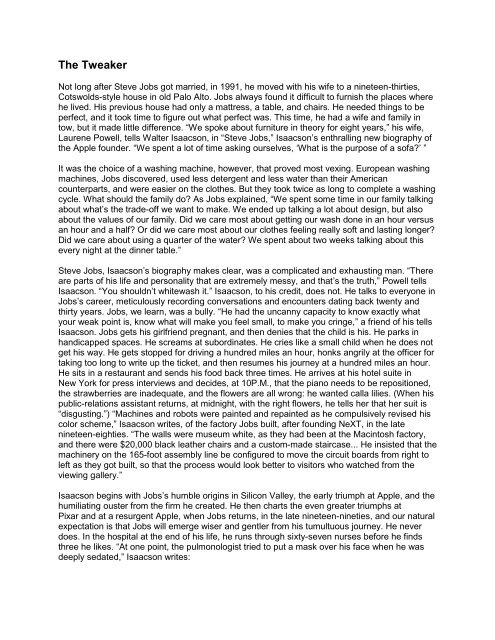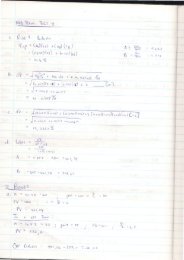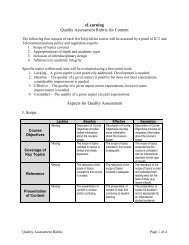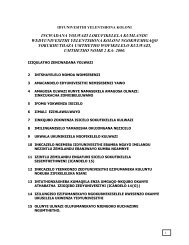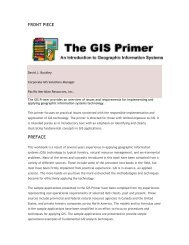The Tweaker
The Tweaker
The Tweaker
You also want an ePaper? Increase the reach of your titles
YUMPU automatically turns print PDFs into web optimized ePapers that Google loves.
<strong>The</strong> <strong>Tweaker</strong>Not long after Steve Jobs got married, in 1991, he moved with his wife to a nineteen-thirties,Cotswolds-style house in old Palo Alto. Jobs always found it difficult to furnish the places wherehe lived. His previous house had only a mattress, a table, and chairs. He needed things to beperfect, and it took time to figure out what perfect was. This time, he had a wife and family intow, but it made little difference. “We spoke about furniture in theory for eight years,” his wife,Laurene Powell, tells Walter Isaacson, in “Steve Jobs,” Isaacson‟s enthralling new biography ofthe Apple founder. “We spent a lot of time asking ourselves, „What is the purpose of a sofa?‟ ”It was the choice of a washing machine, however, that proved most vexing. European washingmachines, Jobs discovered, used less detergent and less water than their Americancounterparts, and were easier on the clothes. But they took twice as long to complete a washingcycle. What should the family do? As Jobs explained, “We spent some time in our family talkingabout what‟s the trade-off we want to make. We ended up talking a lot about design, but alsoabout the values of our family. Did we care most about getting our wash done in an hour versusan hour and a half? Or did we care most about our clothes feeling really soft and lasting longer?Did we care about using a quarter of the water? We spent about two weeks talking about thisevery night at the dinner table.”Steve Jobs, Isaacson‟s biography makes clear, was a complicated and exhausting man. “<strong>The</strong>reare parts of his life and personality that are extremely messy, and that‟s the truth,” Powell tellsIsaacson. “You shouldn‟t whitewash it.” Isaacson, to his credit, does not. He talks to everyone inJobs‟s career, meticulously recording conversations and encounters dating back twenty andthirty years. Jobs, we learn, was a bully. “He had the uncanny capacity to know exactly whatyour weak point is, know what will make you feel small, to make you cringe,” a friend of his tellsIsaacson. Jobs gets his girlfriend pregnant, and then denies that the child is his. He parks inhandicapped spaces. He screams at subordinates. He cries like a small child when he does notget his way. He gets stopped for driving a hundred miles an hour, honks angrily at the officer fortaking too long to write up the ticket, and then resumes his journey at a hundred miles an hour.He sits in a restaurant and sends his food back three times. He arrives at his hotel suite inNew York for press interviews and decides, at 10P.M., that the piano needs to be repositioned,the strawberries are inadequate, and the flowers are all wrong: he wanted calla lilies. (When hispublic-relations assistant returns, at midnight, with the right flowers, he tells her that her suit is“disgusting.”) “Machines and robots were painted and repainted as he compulsively revised hiscolor scheme,” Isaacson writes, of the factory Jobs built, after founding NeXT, in the latenineteen-eighties. “<strong>The</strong> walls were museum white, as they had been at the Macintosh factory,and there were $20,000 black leather chairs and a custom-made staircase... He insisted that themachinery on the 165-foot assembly line be configured to move the circuit boards from right toleft as they got built, so that the process would look better to visitors who watched from theviewing gallery.”Isaacson begins with Jobs‟s humble origins in Silicon Valley, the early triumph at Apple, and thehumiliating ouster from the firm he created. He then charts the even greater triumphs atPixar and at a resurgent Apple, when Jobs returns, in the late nineteen-nineties, and our naturalexpectation is that Jobs will emerge wiser and gentler from his tumultuous journey. He neverdoes. In the hospital at the end of his life, he runs through sixty-seven nurses before he findsthree he likes. “At one point, the pulmonologist tried to put a mask over his face when he wasdeeply sedated,” Isaacson writes:
Jobs ripped it off and mumbled that he hated the design and refused to wear it. Though barelyable to speak, he ordered them to bring five different options for the mask and he would pick adesign he liked. . . . He also hated the oxygen monitor they put on his finger. He told them it wasugly and too complex.One of the great puzzles of the industrial revolution is why it began in England. Why not France,or Germany? Many reasons have been offered. Britain had plentiful supplies of coal, forinstance. It had a good patent system in place. It had relatively high labor costs, whichencouraged the search for labor-saving innovations. In an article published earlier this year,however, the economists Ralf Meisenzahl and Joel Mokyr focus on a different explanation: therole of Britain‟s human-capital advantage—in particular, on a group they call “tweakers.” <strong>The</strong>ybelieve that Britain dominated the industrial revolution because it had a far larger population ofskilled engineers and artisans than its competitors: resourceful and creative men who took thesignature inventions of the industrial age and tweaked them—refined and perfected them, andmade them work.In 1779, Samuel Crompton, a retiring genius from Lancashire, invented the spinning mule,which made possible the mechanization of cotton manufacture. Yet England‟s real advantagewas that it had Henry Stones, of Horwich, who added metal rollers to the mule; and JamesHargreaves, of Tottington, who figured out how to smooth the acceleration and deceleration ofthe spinning wheel; and William Kelly, of Glasgow, who worked out how to add water powerto the draw stroke; and John Kennedy, of Manchester, who adapted the wheel to turn out finecounts; and, finally, Richard Roberts, also of Manchester, a master of precision machinetooling—and the tweaker‟s tweaker. He created the “automatic” spinning mule: an exacting,high-speed, reliable rethinking of Crompton‟s original creation. Such men, the economistsargue, provided the “micro inventions necessary to make macro inventions highly productiveand remunerative.”Was Steve Jobs a Samuel Crompton or was he a Richard Roberts? In the eulogies thatfollowed Jobs‟s death, last month, he was repeatedly referred to as a large-scale visionary andinventor. But Isaacson‟s biography suggests that he was much more of a tweaker. He borrowedthe characteristic features of the Macintosh—the mouse and the icons on the screen—from theengineers at Xerox PARC, after his famous visit there, in 1979. <strong>The</strong> first portable digital musicplayers came out in 1996. Apple introduced the iPod, in 2001, because Jobs looked at theexisting music players on the market and concluded that they “truly sucked.” Smart phonesstarted coming out in the nineteen-nineties. Jobs introduced the iPhone in 2007, more than adecade later, because, Isaacson writes, “he had noticed something odd about the cell phoneson the market: <strong>The</strong>y all stank, just like portable music players used to.” <strong>The</strong> idea for the iPadcame from an engineer at Microsoft, who was married to a friend of the Jobs family, and whoinvited Jobs to his fiftieth-birthday party. As Jobs tells Isaacson:This guy badgered me about how Microsoft was going to completely change the world with thistablet PC software and eliminate all notebook computers, and Apple ought to license hisMicrosoft software. But he was doing the device all wrong. It had a stylus. As soon as you havea stylus, you’re dead. This dinner was like the tenth time he talked to me about it, and I was sosick of it that I came home and said, “Screw this, let’s show him what a tablet can really be.”Even within Apple, Jobs was known for taking credit for others‟ ideas. Jonathan Ive, thedesigner behind the iMac, the iPod, and the iPhone, tells Isaacson, “He will go through aprocess of looking at my ideas and say, „That‟s no good. That‟s not very good. I like that one.‟And later I will be sitting in the audience and he will be talking about it as if it was his idea.”
Jobs‟s sensibility was editorial, not inventive. His gift lay in taking what was in front of him—thetablet with stylus—and ruthlessly refining it. After looking at the first commercials for the iPad,he tracked down the copywriter, James Vincent, and told him, “Your commercials suck.”“Well, what do you want?” Vincent shot back. “You’ve not been able to tell me what you want.”“I don’t know,” Jobs said. “You have to bring me something new. Nothing you’ve shown me iseven close.”Vincent argued back and suddenly Jobs went ballistic. “He just started screaming at me,”Vincent recalled. Vincent could be volatile himself, and the volleys escalated.When Vincent shouted, “You’ve got to tell me what you want,” Jobs shot back, “You’ve got toshow me some stuff, and I’ll know it when I see it.”I’ll know it when I see it. That was Jobs‟s credo, and until he saw it his perfectionism kept himon edge. He looked at the title bars—the headers that run across the top of windows anddocuments—that his team of software developers had designed for the original Macintosh anddecided he didn‟t like them. He forced the developers to do another version, and then another,about twenty iterations in all, insisting on one tiny tweak after another, and when the developersprotested that they had better things to do he shouted, “Can you imagine looking at that everyday? It‟s not just a little thing. It‟s something we have to do right.”<strong>The</strong> famous Apple “Think Different” campaign came from Jobs‟s advertising team atTBWA\Chiat\Day. But it was Jobs who agonized over the slogan until it was right:<strong>The</strong>y debated the grammatical issue: If “different” was supposed to modify the verb “think,” itshould be an adverb, as in “think differently.” But Jobs insisted that he wanted “different” to beused as a noun, as in “think victory” or “think beauty.” Also, it echoed colloquial use, as in “thinkbig.” Jobs later explained, “We discussed whether it was correct before we ran it.It‟s grammatical, if you think about what we‟re trying to say. It‟s not think the same, it‟s thinkdifferent. Think a little different, think a lot different, think different. „Think differently’ wouldn‟t hitthe meaning for me.”<strong>The</strong> point of Meisenzahl and Mokyr‟s argument is that this sort of tweaking is essential toprogress. James Watt invented the modern steam engine, doubling the efficiency of the enginesthat had come before. But when the tweakers took over the efficiency of the steam engineswiftly quadrupled. Samuel Crompton was responsible for what Meisenzahl and Mokyr call“arguably the most productive invention” of the industrial revolution. But the key moment, in thehistory of the mule, came a few years later, when there was a strike of cotton workers. <strong>The</strong> millowners were looking for a way to replace the workers with unskilled labor, and needed anautomatic mule, which did not need to be controlled by the spinner. Who solved the problem?Not Crompton, an unambitious man who regretted only that public interest would not leave himto his seclusion, so that he might “earn undisturbed the fruits of his ingenuity andperseverance.” It was the tweaker‟s tweaker, Richard Roberts, who saved the day, producing aprototype, in 1825, and then an even better solution in 1830. Before long, the number ofspindles on a typical mule jumped from four hundred to a thousand. <strong>The</strong> visionary starts with aclean sheet of paper, and re-imagines the world. <strong>The</strong> tweaker inherits things as they are, andhas to push and pull them toward some more nearly perfect solution. That is not a lesser task.Jobs‟s friend Larry Ellison, the founder of Oracle, had a private jet, and he designed its interiorwith a great deal of care. One day, Jobs decided that he wanted a private jet, too. He studiedwhat Ellison had done. <strong>The</strong>n he set about to reproduce his friend‟s design in its entirety— thesame jet, the same reconfiguration, the same doors between the cabins. Actually, not in itsentirety. Ellison‟s jet “had a door between cabins with an open button and a close button,”
Isaacson writes. “Jobs insisted that his have a single button that toggled. He didn‟t like thepolished stainless steel of the buttons, so he had them replaced with brushed metal ones.”Having hired Ellison‟s designer, “pretty soon he was driving her crazy.” Of course he was. <strong>The</strong>great accomplishment of Jobs‟s life is how effectively he put his idiosyncrasies—his petulance,his narcissism, and his rudeness—in the service of perfection. “I look at his airplane and mine,”Ellison says, “and everything he changed was better.”<strong>The</strong> angriest Isaacson ever saw Steve Jobs was when the wave of Android phones appeared,running the operating system developed by Google. Jobs saw the Android handsets, with theirtouchscreens and their icons, as a copy of the iPhone. He decided to sue. As he tells IsaacsonOur lawsuit is saying, “Google, you ripped off the iPhone, wholesale ripped us off.” Grand theft. Iwill spend my last dying breath if I need to, and I will spend every penny of Apple’s $40 billion inthe bank, to right this wrong. I’m going to destroy Android, because it’s a stolen product. I’mwilling to go to thermonuclear war on this. <strong>The</strong>y are scared to death, because they know theyare guilty. Outside of Search, Google’s products—Android, Google Docs—suck.In the nineteen-eighties, Jobs reacted the same way when Microsoft came out with Windows.It used the same graphical user interface—icons and mouse—as the Macintosh. Jobs wasoutraged and summoned Gates from Seattle to Apple‟s Silicon Valley headquarters. “<strong>The</strong>y metin Jobs‟s conference room, where Gates found himself surrounded by ten Apple employees whowere eager to watch their boss assail him,” Isaacson writes. “Jobs didn‟t disappoint his troops.„You‟re ripping us off!‟ he shouted. „I trusted you, and now you‟re stealing from us!‟ ”Gates looked back at Jobs calmly. Everyone knew where the windows and the icons camefrom. “Well, Steve,” Gates responded. “I think there‟s more than one way of looking at it. I thinkit‟s more like we both had this rich neighbor named Xerox and I broke into his house to steal theTV set and found out that you had already stolen it.”Jobs was someone who took other people‟s ideas and changed them. But he did not like itwhen the same thing was done to him. In his mind, what he did was special. Jobs persuadedthe head of Pepsi-Cola, John Sculley, to join Apple as C.E.O., in 1983, by asking him, “Do youwant to spend the rest of your life selling sugared water, or do you want a chance to change theworld?” When Jobs approached Isaacson to write his biography, Isaacson first thought (“halfjokingly”) that Jobs had noticed that his two previous books were on Benjamin Franklin andAlbert Einstein, and that he “saw himself as the natural successor in that sequence.” <strong>The</strong>architecture of Apple software was always closed. Jobs did not want the iPhone and the iPodand the iPad to be opened up and fiddled with, because in his eyes they were perfect. <strong>The</strong>greatest tweaker of his generation did not care to be tweaked.Perhaps this is why Bill Gates—f all Jobs‟s contemporaries—ave him fits. Gates resisted theromance of perfectionism. Time and again, Isaacson repeatedly asks Jobs about Gates andJobs cannot resist the gratuitous dig. “Bill is basically unimaginative,” Jobs tells Isaacson, “andhas never invented anything, which I think is why he‟s more comfortable now in philanthropythan technology. He just shamelessly ripped off other people‟s ideas.”After close to six hundred pages, the reader will recognize this as vintage Jobs: equal partsinsightful, vicious, and delusional. It‟s true that Gates is now more interested in trying toeradicate malaria than in overseeing the next iteration of Word. But this is not evidence of a lackof imagination. Philanthropy on the scale that Gates practices it represents imagination at itsgrandest. In contrast, Jobs‟s vision, brilliant and perfect as it was, was narrow. He was atweaker to the last, endlessly refining the same territory he had claimed as a young man.
As his life wound down, and cancer claimed his body, his great passion was designing Apple‟snew, three-million-square-foot headquarters, in Cupertino. Jobs threw himself into the details.“Over and over he would come up with new concepts, sometimes entirely new shapes, andmake them restart and provide more alternatives,” Isaacson writes. He was obsessed withglass, expanding on what he learned from the big panes in the Apple retail stores. “<strong>The</strong>re wouldnot be a straight piece of glass in the building,” Isaacson writes. “All would be curved andseamlessly joined. . . . <strong>The</strong> planned center courtyard was eight hundred feet across (morethan three typical city blocks, or almost the length of three football fields), and he showed it tome with overlays indicating how it could surround St. Peter‟s Square in Rome.” <strong>The</strong> architectswanted the windows to open. Jobs said no. He “had never liked the idea of people being able toopen things. „That would just allow people to screw things up.‟ ”By Malcom GladwellSource : newyorker.com__


